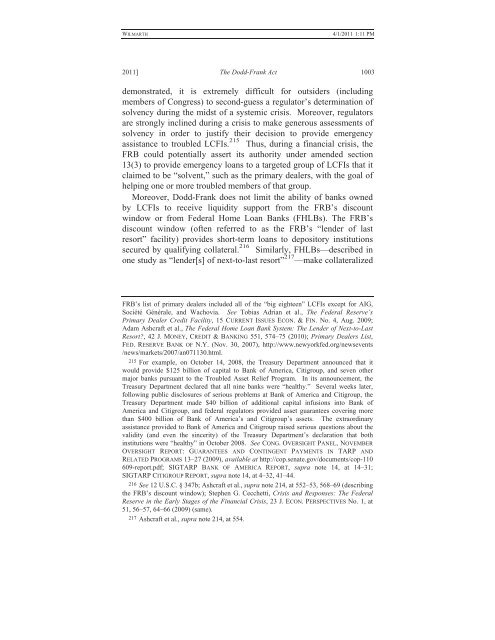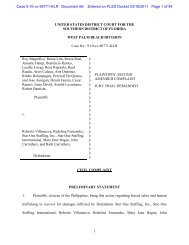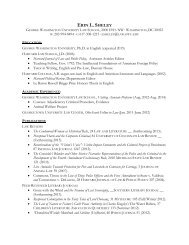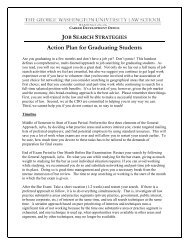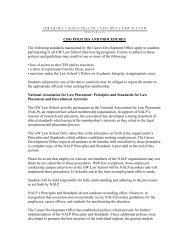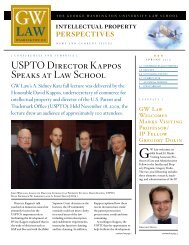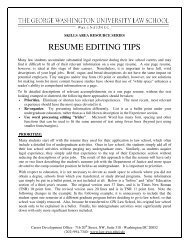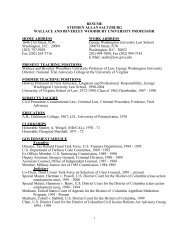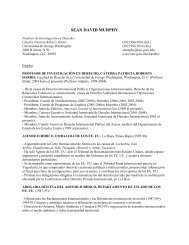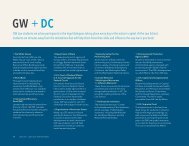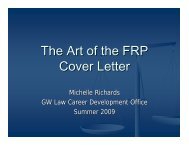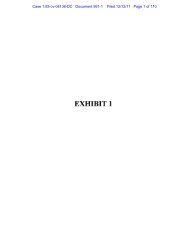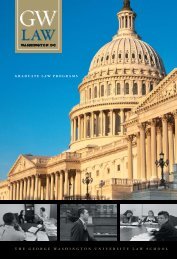CLE Materials for Panel #1 - George Washington University Law ...
CLE Materials for Panel #1 - George Washington University Law ...
CLE Materials for Panel #1 - George Washington University Law ...
Create successful ePaper yourself
Turn your PDF publications into a flip-book with our unique Google optimized e-Paper software.
WILMARTH<br />
4/1/2011 1:11 PM<br />
2011] The Dodd-Frank Act 1003<br />
demonstrated, it is extremely difficult <strong>for</strong> outsiders (including<br />
members of Congress) to second-guess a regulator’s determination of<br />
solvency during the midst of a systemic crisis. Moreover, regulators<br />
are strongly inclined during a crisis to make generous assessments of<br />
solvency in order to justify their decision to provide emergency<br />
assistance to troubled LCFIs. 215 Thus, during a financial crisis, the<br />
FRB could potentially assert its authority under amended section<br />
13(3) to provide emergency loans to a targeted group of LCFIs that it<br />
claimed to be “solvent,” such as the primary dealers, with the goal of<br />
helping one or more troubled members of that group.<br />
Moreover, Dodd-Frank does not limit the ability of banks owned<br />
by LCFIs to receive liquidity support from the FRB’s discount<br />
window or from Federal Home Loan Banks (FHLBs). The FRB’s<br />
discount window (often referred to as the FRB’s “lender of last<br />
resort” facility) provides short-term loans to depository institutions<br />
secured by qualifying collateral. 216 Similarly, FHLBs—described in<br />
one study as “lender[s] of next-to-last resort” 217 —make collateralized<br />
FRB’s list of primary dealers included all of the “big eighteen” LCFIs except <strong>for</strong> AIG,<br />
Société Générale, and Wachovia. See Tobias Adrian et al., The Federal Reserve’s<br />
Primary Dealer Credit Facility, 15 CURRENT ISSUES ECON. &FIN. No. 4, Aug. 2009;<br />
Adam Ashcraft et al., The Federal Home Loan Bank System: The Lender of Next-to-Last<br />
Resort?, 42 J. MONEY, CREDIT &BANKING 551, 574–75 (2010); Primary Dealers List,<br />
FED. RESERVE BANK OF N.Y. (Nov. 30, 2007), http://www.newyorkfed.org/newsevents<br />
/news/markets/2007/an071130.html.<br />
215 For example, on October 14, 2008, the Treasury Department announced that it<br />
would provide $125 billion of capital to Bank of America, Citigroup, and seven other<br />
major banks pursuant to the Troubled Asset Relief Program. In its announcement, the<br />
Treasury Department declared that all nine banks were “healthy.” Several weeks later,<br />
following public disclosures of serious problems at Bank of America and Citigroup, the<br />
Treasury Department made $40 billion of additional capital infusions into Bank of<br />
America and Citigroup, and federal regulators provided asset guarantees covering more<br />
than $400 billion of Bank of America’s and Citigroup’s assets. The extraordinary<br />
assistance provided to Bank of America and Citigroup raised serious questions about the<br />
validity (and even the sincerity) of the Treasury Department’s declaration that both<br />
institutions were “healthy” in October 2008. See CONG. OVERSIGHT PANEL, NOVEMBER<br />
OVERSIGHT REPORT: GUARANTEES AND CONTINGENT PAYMENTS IN TARP AND<br />
RELATED PROGRAMS 13–27 (2009), available at http://cop.senate.gov/documents/cop-110<br />
609-report.pdf; SIGTARP BANK OF AMERICA REPORT, supra note 14, at 14–31;<br />
SIGTARP CITIGROUP REPORT, supra note 14, at 4–32, 41–44.<br />
216 See 12 U.S.C. § 347b; Ashcraft et al., supra note 214, at 552–53, 568–69 (describing<br />
the FRB’s discount window); Stephen G. Cecchetti, Crisis and Responses: The Federal<br />
Reserve in the Early Stages of the Financial Crisis, 23 J. ECON. PERSPECTIVES No. 1, at<br />
51, 56–57, 64–66 (2009) (same).<br />
217 Ashcraft et al., supra note 214, at 554.


